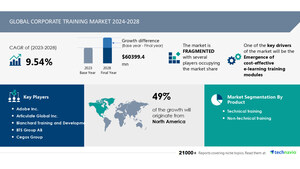NEW YORK, April 16, 2024 /PRNewswire/ -- The global biostimulants market size is estimated to grow by USD 1.51 bn from 2023-2027, according to Technavio. The market is estimated to grow at a CAGR of over 10.68% during the forecast period. Biostimulants are formulations enhancing plant growth and crop production. Key components include protein hydrolysates, humic substances, kelp extracts, and microbial-derived enzymes. Benefits include improved metabolism, stress tolerance, nutrient use, and water efficiency. Leading agriculture markets like China, India, US, and Brazil utilize biostimulants in various crops and applications such as foliar treatments, seed and soil treatments, and primary/secondary metabolites.
For more insights on the historic (2017 - 2021) and forecast market size- Request a sample report
Biostimulants Market Scope |
|
Report Coverage |
Details |
Base year |
2022 |
Historic period |
2017 - 2021 |
Forecast period |
2023-2027 |
Growth momentum & CAGR |
Accelerate at a CAGR of 10.68% |
Market growth 2023-2027 |
USD 1.51 billion |
Market structure |
Fragmented |
YoY growth 2022-2023 (%) |
8.45 |
Regional analysis |
Europe, APAC, North America, South America, and Middle East and Africa |
Performing market contribution |
North America at 32% |
Key countries |
US, Canada, China, Japan, India, and Germany |
Key companies profiled |
ADAMA Ltd., Bayer AG, Bioiberica S.A.U., Biolchim Spa, Biostadt India Ltd., Biovert SL, Crop Demetra Ltd., FMC Corp., Haifa Group, Idai Nature S.L, Italpollina Spa, Koppert, Micromix Plant Health Ltd., Novozymes AS, OMEX, RAG Stiftung, SEIPASA SA, SICIT Group Spa, UPL Ltd., and Atlantica Agricola |
Segment Overview
This biostimulants market report extensively covers market segmentation by Product (Acid-based, Extract-based, Others) Application (Foliar, Soil, Seed) Type (Row crops and cereals, Fruits and vegetables, Turfs and ornaments, Others) Geography (Europe, APAC, North America, South America, Middle East and Africa)
Market segmentation by Product
The Biostimulants Market encompasses a range of products, including protein hydrolysates, synthetic chemical fertilizers, and plant-derived solutions such as glycine betaine, chelated nutrients, and isopentenyl adenosine (IPA). These biostimulants, widely used in foliar applications, promote plant growth and improve crop quality by enhancing metabolic efficiency, facilitating nutrient translocation, and increasing tolerance to abiotic stresses. With population growth and climate change threatening natural resources and biodiversity loss, the demand for biostimulants in soil conditioning, crop improvement, and production is escalating. Biostimulants are applied to various crops, including oilseeds and pulses, durum wheat, and podded crops, through foliar treatments, seed treatment, and soil treatment. Key components include primary and secondary metabolites, plant chemicals, amino acids, betaines, peptides, proteins, sugars, aminopolysaccharides, lipids, vitamins, nucleotides, nucleosides, humic chemicals, and beneficial microorganisms. Regulations, such as the Nitrates Directive, govern the use of certain biostimulants, ensuring sustainable agricultural practices.
Geography Overview
The Biostimulants Market in Europe is experiencing significant growth due to the dominance of Hungary, Greece, the Czech Republic, and France in the regional agriculture sector. The increasing demand for meat in leading producers such as Belgium, France, Greece, Sweden, the UK, Germany, and Russia, necessitates large quantities of livestock, driving the need for good-quality grass through pastureland expansion. In the Fruits & Vegetables segment, biostimulants extend shelf-life, improve farm yield, and enhance crop quality. These products contain protein hydrolysates, synthetic chemical fertilizers, and natural alternatives like humic substances, kelp extracts, biopolymers, microbial-derived enzymes, phosphite, silicon, and foliar treatments. Addressing environmental concerns, organic products, and germination, biostimulants also offer crop protection and improvement, and are essential for oilseeds and pulses, durum wheat, and podded crops. Amid population growth, climate change, and biodiversity loss, biostimulants play a crucial role in maintaining soil condition, crop production, and water irrigation, as well as in soil reclamation. The Nitrates Directive regulates the use of certain fertilizers, making biostimulants a valuable alternative for sustainable agriculture.
Insights on the market contribution of various segments including country and region wise, historic (2017 - 2021) and forecast market size- Download a Sample Report
- The global arable land has decreased due to urbanization, industrialization, and population growth. Developing nations like China and India need an extra 120 million hectares of land for food production by 2030. In response, the biostimulants market offers solutions through products like oilseeds, pulses, nitrates, and phosphites, as well as plant biostimulants, hydrolysates, and humic substances, enhancing crop yield under abiotic stress and improving land fertility.
- Biostimulants, derived from micronutrients, enhance crop quality and soil fertility. These trace minerals, including zinc, iron, phosphorus, and magnesium, are essential for plant growth and function. Deficiencies can lead to low yields, reduced growth, and abnormalities. Biostimulants, used in horticulture and agriculture, improve crop nutritional content and are key fertilizer components. They boost crop water efficiency, protect against abiotic stress, and contribute to soil reclamation. Government bodies promote their use in addressing environmental concerns, population growth, and climate change. Industries focus on biostimulants like foliar sprays, protein hydrolysates, and synthetic chemical fertilizers for improved crop yield and quality.
Insights on Market Drivers, trends, & Challenges, historic period(2017 - 2021) and forecast period(2023-2027)- Request a sample report!
Research Analysis
The Biostimulants Market is experiencing significant growth due to the increasing global population and climate change, which put pressure on natural resources and biodiversity loss. Biostimulants, such as protein hydrolysates, play a crucial role in enhancing soil condition, crop quality, and plant growth, ultimately leading to improved crop yield and production. These products are essential for crop improvement in various agricultural sectors, including oilseeds and pulses, vegetables, and Food products. Biostimulants also help plants cope with abiotic stress caused by global warming and climatic scenarios. Furthermore, beneficial microorganisms and crop water efficiency are key components of biostimulants, contributing to soil reclamation and sustainable agriculture practices. Overall, biostimulants offer a sustainable solution to address the challenges of feeding a growing population while minimizing the environmental impact of synthetic chemical fertilizers.
Market Research Overview
The Biostimulants Market represents a significant segment in the agricultural industry, driven by the increasing demand for sustainable farming practices. These innovative products, including proteins, carbohydrates, and nucleotides, enhance soil fertility and improve crop productivity. Protients, such as humic and fulvic acids, play a crucial role in nutrient uptake, while carbohydrates contribute to plant growth and development. Nucleotides promote cell division and enhance stress resistance. The market is further propelled by the growing adoption of biostimulants in horticulture and turf management. The use of biostimulants in organic farming is also on the rise, as they comply with organic farming regulations. The market is expected to grow steadily due to the increasing awareness of the environmental benefits of biostimulants and the continuous research and development in this field. The crop types covered in the market include fruits, vegetables, cereals, and oilseeds. Major players in the market include BASF SE, Haifa Group, and Valagro S.p.A. The market is segmented by type, application, and region. The use of biostimulants is projected to increase in the Asia Pacific region due to the large agricultural population and the growing demand for food security. The market is also expected to grow in Europe and North America due to the increasing awareness of sustainable farming practices and the presence of major market players in these regions.
About Technavio
Technavio is a leading global technology research and advisory company. Their research and analysis focuses on emerging market trends and provides actionable insights to help businesses identify market opportunities and develop effective strategies to optimize their market positions.
With over 500 specialized analysts, Technavio's report library consists of more than 17,000 reports and counting, covering 800 technologies, spanning across 50 countries. Their client base consists of enterprises of all sizes, including more than 100 Fortune 500 companies. This growing client base relies on Technavio's comprehensive coverage, extensive research, and actionable market insights to identify opportunities in existing and potential markets and assess their competitive positions within changing market scenarios.
Contacts
Technavio Research
Jesse Maida
Media & Marketing Executive
US: +1 844 364 1100
UK: +44 203 893 3200
Email: [email protected]
Website: www.technavio.com/
SOURCE Technavio

WANT YOUR COMPANY'S NEWS FEATURED ON PRNEWSWIRE.COM?
Newsrooms &
Influencers
Digital Media
Outlets
Journalists
Opted In




Share this article